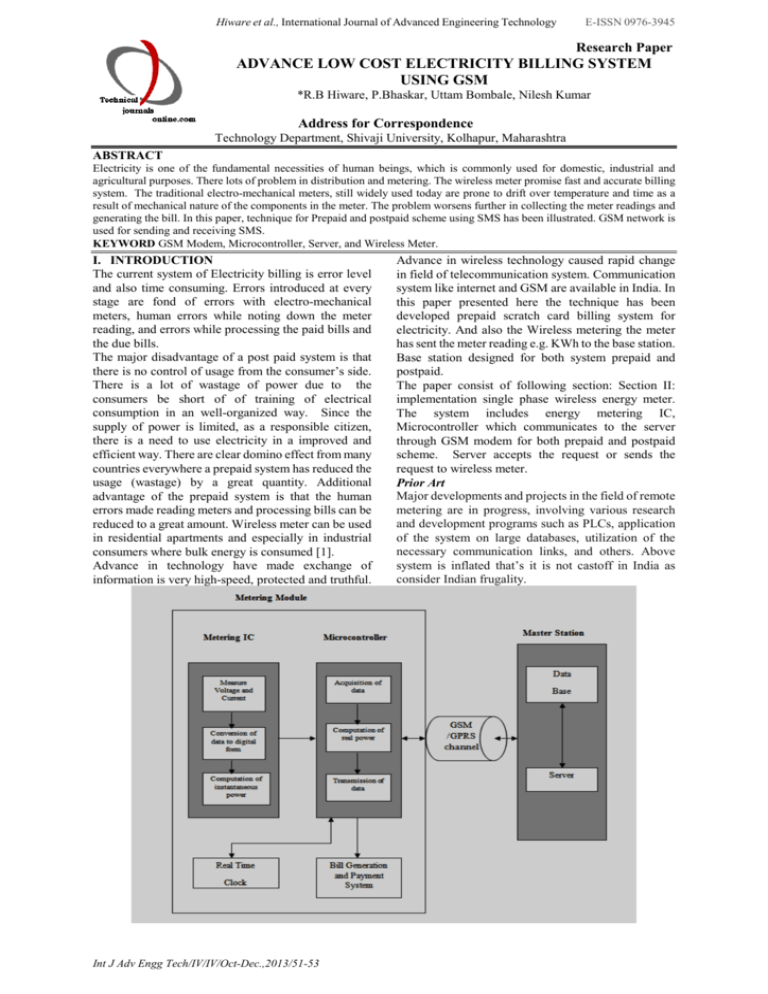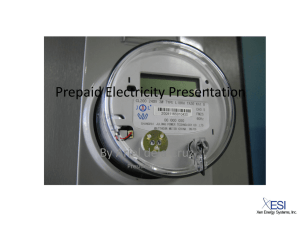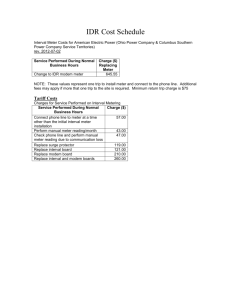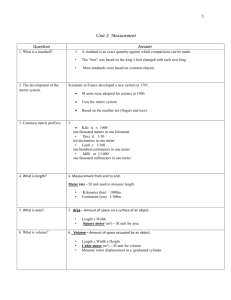advance low cost electricity billing system using gsm
advertisement

Hiware et al., International Journal of Advanced Engineering Technology E-ISSN 0976-3945 Research Paper ADVANCE LOW COST ELECTRICITY BILLING SYSTEM USING GSM *R.B Hiware, P.Bhaskar, Uttam Bombale, Nilesh Kumar Address for Correspondence Technology Department, Shivaji University, Kolhapur, Maharashtra ABSTRACT Electricity is one of the fundamental necessities of human beings, which is commonly used for domestic, industrial and agricultural purposes. There lots of problem in distribution and metering. The wireless meter promise fast and accurate billing system. The traditional electro-mechanical meters, still widely used today are prone to drift over temperature and time as a result of mechanical nature of the components in the meter. The problem worsens further in collecting the meter readings and generating the bill. In this paper, technique for Prepaid and postpaid scheme using SMS has been illustrated. GSM network is used for sending and receiving SMS. KEYWORD GSM Modem, Microcontroller, Server, and Wireless Meter. I. INTRODUCTION The current system of Electricity billing is error level and also time consuming. Errors introduced at every stage are fond of errors with electro-mechanical meters, human errors while noting down the meter reading, and errors while processing the paid bills and the due bills. The major disadvantage of a post paid system is that there is no control of usage from the consumer’s side. There is a lot of wastage of power due to the consumers be short of of training of electrical consumption in an well-organized way. Since the supply of power is limited, as a responsible citizen, there is a need to use electricity in a improved and efficient way. There are clear domino effect from many countries everywhere a prepaid system has reduced the usage (wastage) by a great quantity. Additional advantage of the prepaid system is that the human errors made reading meters and processing bills can be reduced to a great amount. Wireless meter can be used in residential apartments and especially in industrial consumers where bulk energy is consumed [1]. Advance in technology have made exchange of information is very high-speed, protected and truthful. Int J Adv Engg Tech/IV/IV/Oct-Dec.,2013/51-53 Advance in wireless technology caused rapid change in field of telecommunication system. Communication system like internet and GSM are available in India. In this paper presented here the technique has been developed prepaid scratch card billing system for electricity. And also the Wireless metering the meter has sent the meter reading e.g. KWh to the base station. Base station designed for both system prepaid and postpaid. The paper consist of following section: Section II: implementation single phase wireless energy meter. The system includes energy metering IC, Microcontroller which communicates to the server through GSM modem for both prepaid and postpaid scheme. Server accepts the request or sends the request to wireless meter. Prior Art Major developments and projects in the field of remote metering are in progress, involving various research and development programs such as PLCs, application of the system on large databases, utilization of the necessary communication links, and others. Above system is inflated that’s it is not castoff in India as consider Indian frugality. Hiware et al., International Journal of Advanced Engineering Technology I. IMPLEMENTATION The system consists of wireless meter and the server which is shown in fig 1. The wireless meter placed in homes, company and the buildings which have exchange the information using the GSM network through SMS. Both the prepaid and post paid system implemented using this architecture. A. Wireless Meter The metering module consists of a Microcontroller, metering IC, LCD i.e. liquid crystal display, EEPROM, Relay, GSM module and Keypad. Fig 1 Wireless Electricity Meter B. Microcontroller Unit PIC microcontroller is used as main unit. The PIC is an 8 bit Reduced Instruction set computer (RISC) Microcontroller. It is one of the most popular microcontrollers for its high performance and low cost. It has three 8 bit ports, one 6 bit and one three bit port so total 33 I/O lines. Fig 2 shows block diagram of wireless meter. It has 8 KB of program memory and 368 data memory. The program inside the microcontroller contain the protocol for accessing different hardware peripheral such as LCD,EEPROM, Relay, Metering IC, GSM Module. And applications contain the billing calculation and send the SMS. C. Display Unit 16x2 Character LCD is interfaced with microcontroller using 4 wire modes. The meter reading i.e. KWh, total KWh, cost KWh, last billing date (Post paid scheme) and remaining KWh in prepaid scheme etc. Electrical Erasable Read only Memory (EEPROM) When the power fail occurs, the all reading is stored in EEPROM so that when power is back on, the meter can start from its last state. An I2C EEPROM (AT24C64) of 8KB size is used. E-ISSN 0976-3945 directly drive the electromechanical counter or interface with MCU. The frequency output CF is connected to a microcontroller pin. This will count the number of pulses in given time. The average power proportional to the average frequency is given by Average frequency = Average power = Counter/Time The energy consumed during the integration period is given by Energy = Average Power x Time = (counter/ time) x time The ADE 7757 calculates the product of two voltage signals (on channel V1 and V2) and then low- pass filters this product to exact real power information. This real power information is then converted to a frequency. The frequency information is output on F1 and F2 in the form of active low pulses. The result is an output frequency that is proportional to the average real power. [3] E. Relay Unit A relay is used for connecting and disconnecting power supply to the costumer s load. The microcontroller sends signals to the relay input signal pins to control the relay contacts F. GSM Modem A GSM modem is interfaced with the microcontroller serial port for sending and receiving SMS. Using AT command Protocol, [2] microcontroller send the different commands to the modem. AT-commands which stand for ATTENTION TERMINAL are used by processing unit to communicate with the GSM Modem. This whole operation is based on the instructions that are passed by processing unit. This modem and the processing unit are linked by means of RS-232 communication protocol [4]. This operates under the following configuration, • Baud Rate = 9600 • Parity Bit = None • Byte Size = 8 • Stop Bit =1 Some of the main and frequently used AT-Commands are given below as also used in, • AT (Attention Command) • AT+CMGL (List message) • AT+CMGF (Selecting messaging mode) • AT+CMGS (Send message) • AT +CMGR (Read message) • AT+CMGD (Delete message) G. Keypad A 3x4 keypad is integrated with meter module. Use full in prepaid mode. The key available on this keypad start from 0-9 and one enter key II. CENTRAL SERVER Server mainly consist of GSM Hardware unit and several software module which shown in fig 3. Fig. 2 Block Diagram of Wireless Meter D. Metering Module The metering module (ADE 7757) is used. The ADE 7757 is mixed signal single phase metering IC. It supplies average real power information on the low frequency outputs F1 and F2. These outputs may Int J Adv Engg Tech/IV/IV/Oct-Dec.,2013/51-53 Fig 3 Block Diagram Serve It consists of GSM module which used for sending and receiving the SMS using AT command [2]. To Hiware et al., International Journal of Advanced Engineering Technology E-ISSN 0976-3945 interface modem with server the MCU is used. Communication is done using the serial protocol. Server’s Serial port (RS 232) and 8051 with RS232 module used between them. A. Server Software Our system the central server is built on windows XP operating system with VB programming Language. The software composed several module which shown in fig 3.The data communication module communicate to 8051 microcontroller through serial communication. Microcontroller 8051 is communicating to GSM through AT Commands. When server wants collect information from particular remote location meter, it send request SMS message to particular meter and wait for data from GSM module. After the remote meter receives the Request SMS massage, it makes a data frame consisting of the meter’s information and sends it to the server by SMS. The server then gets the SMS data from the GSM modem and stores the information in the Database. Fig 4 shows the flow chart of post paid billing system. Fig5 Prepaid Billing Systems III. CONCLUSION In this paper, an SMS based Wireless metering system has been proposed. Different hardware and firmware unit of the wireless meter is described. The central server’s different modules and the communication protocol with the wireless meters are also shown. We have illustrated both postpaid and prepaid billing scheme. REFERENCES 1. 2. 3. 4. 5. Fig. 4 Post paid Billing System The data collection can be done at any time or periodically such as monthly basis. The Monitoring & Analysis Module gets data from the Database and calculates the overall energy consumption of the meter. Server operator can send Disconnection SMS massage to the wireless meter to disconnect the meters relay contacts and thus stop the customer to consume further energy. Pre-paid scratch-card based billing scheme can also be implemented using the SMS based technique. The electric supplier will produce scratch-cards. Customers will buy scratch-cards and send the SMS through keypad included in Wireless meter to the central server consisting of the customer’s meter ID and the scratch-card’s secret pin number. When the central server receives the SMS, it checks the validity of the pin number from the database and meter ID. If the meter ID is valid and the pin number is also valid and still unused, then the server sends an SMS to the customer’s meter which contains the information of how much balance will be recharged in the meter. The meter receives the SMS, decode it and recharge the balance. Fig 5 shows prepaid billing system. Int J Adv Engg Tech/IV/IV/Oct-Dec.,2013/51-53 6. 7. Q. Hao and Z.Song. “The Status and Development of the Intelligent Automatic Meter Reading System”, proc of China Science and Technology Information, no.19, pp.72, October 2005 Panjiyar, P. Mourya, P. Bansal, N. Srivastava, P. Mukherjee "Transport security using mobile technology" ,Intelligence and Security Informatics, 2008. lSI 2008.1EEE. Energy Metering IC with Integrated Oscillator”, ADE7757. Available at http://www.analog.com www.gsm-modem.de/gsm-module.html L. Cao, J. Tian and D. Zhang, “Networked Remote Meter Reading System based on Wireless Communication Technology”, proc. of IEEE International Conference on Information Acquisition, China, August 2006 Embedtronics, http://www.embedtronics.com, 2005 Energy Controls, http://www.energycontrols.org, 2007






